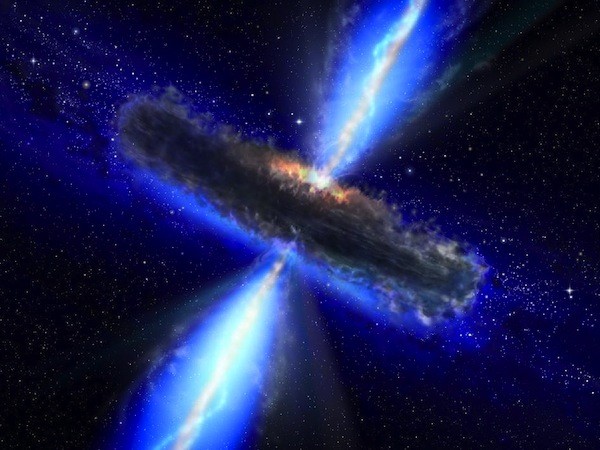
An artist’s illustration of a quasar similar to APM 08279+5255. Credit NASA/ESA
Two teams of scientists at the California Institute of Technology (Caltech) have discovered the largest reservoir of water ever found. Unfortunately for us mariners, the find doesn’t translate into more jobs – that’s because the water is located some 12 billion lights years away.
While studying a quasar, or feeding black hole, some 12 billion light years away, the scientists found a mass of water large enough to fill the Earth’s oceans 140 trillion times, or 100,000 times more massive than the sun.
“The environment around this quasar is unique in that it’s producing this huge mass of water,” says Matt Bradford, a scientist at NASA’s Jet Propulsion Laboratory (JPL), and a visiting associate at Caltech. “It’s another demonstration that water is pervasive throughout the universe, even at the very earliest times.” Bradford leads one of two international teams of astronomers that have described their quasar findings in separate papers that have been accepted for publication in the Astrophysical Journal Letters. Caltech explains:
A quasar is powered by an enormous black hole that is steadily consuming a surrounding disk of gas and dust; as it eats, the quasar spews out huge amounts of energy. Both groups of astronomers studied a particular quasar called APM 08279+5255, which harbors a black hole 20 billion times more massive than the sun and produces as much energy as a thousand trillion suns.
Since astronomers expected water vapor to be present even in the early universe, the discovery of water is not itself a surprise, Bradford says. There’s water vapor in the Milky Way, although the total amount is 4,000 times less massive than in the quasar, as most of the Milky Way’s water is frozen in the form of ice.
Nevertheless, water vapor is an important trace gas that reveals the nature of the quasar. In this particular quasar, the water vapor is distributed around the black hole in a gaseous region spanning hundreds of light-years (a light-year is about six trillion miles), and its presence indicates that the gas is unusually warm and dense by astronomical standards. Although the gas is a chilly –53 degrees Celsius (–63 degrees Fahrenheit) and is 300 trillion times less dense than Earth’s atmosphere, it’s still five times hotter and 10 to 100 times denser than what’s typical in galaxies like the Milky Way.
The water vapor is just one of many kinds of gas that surround the quasar, and its presence indicates that the quasar is bathing the gas in both X-rays and infrared radiation. The interaction between the radiation and water vapor reveals properties of the gas and how the quasar influences it. For example, analyzing the water vapor shows how the radiation heats the rest of the gas. Furthermore, measurements of the water vapor and of other molecules, such as carbon monoxide, suggest that there is enough gas to feed the black hole until it grows to about six times its size. Whether this will happen is not clear, the astronomers say, since some of the gas may end up condensing into stars or may be ejected from the quasar. Keep reading…
Source: Caltech via Wired

 Join The Club
Join The Club









